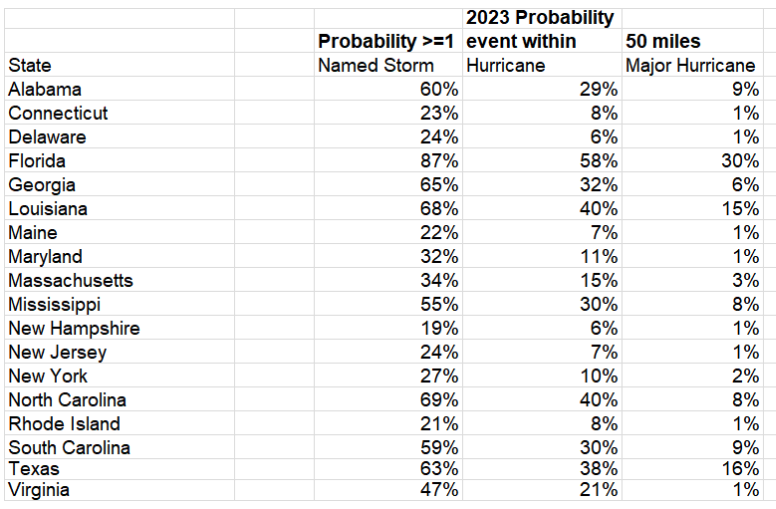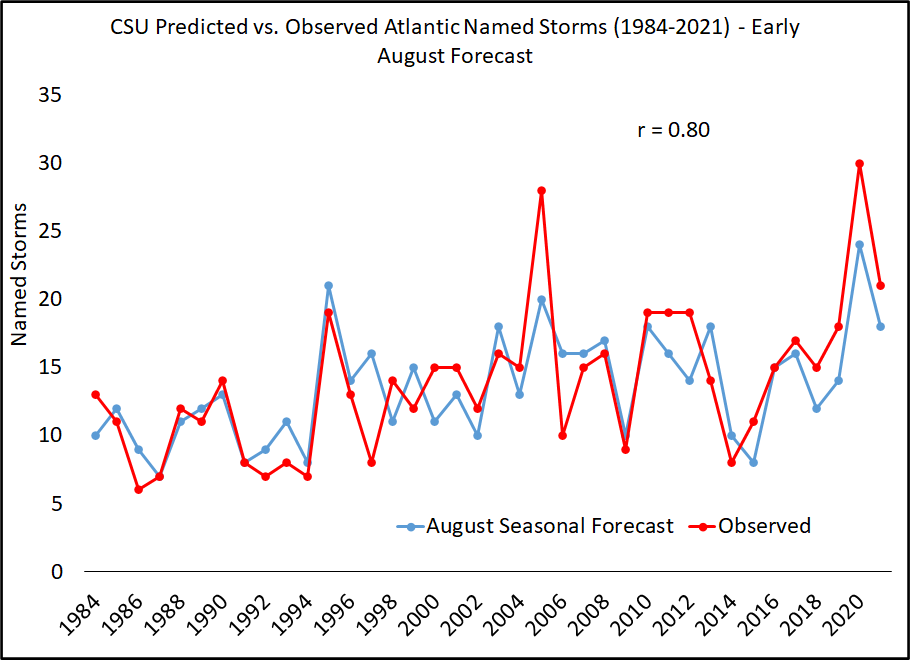For the 40th year, Colorado State University's hurricane researchers have released their predictions for the 2023 hurricane season in the Atlantic Ocean.
The researchers determined that a slightly below-average Atlantic Ocean season is expected for this year when compared to about 30 years of data, explained Alex DesRosiers, a Ph.D. candidate in the CSU Department of Atmospheric Science and co-author of the report.
"So, there's actually a little bit of push-pull this year and there's higher uncertainty than you usually get, even though it's hard to predict in April," he said. "This is one of those Aprils that's just a little bit harder."
DesRosiers said there are two things working against each other. First, sea surface temperatures in the far eastern and tropical Atlantic regions are running much warmer than normal.
"And when you have the surface temperatures that are warm, hurricanes like to use that as fuel," he said. "Warm ocean water is a really important ingredient to making these storms."
And second, hurricanes exist in the atmosphere above the ocean, which will likely be dictated by the El Niño expected to form by peak Atlantic hurricane season. El Niño typically inhibits hurricane activity in the Atlantic and strengthens it in the central and eastern Pacific basins.

"So, regardless of those warm ocean temperatures, we are hoping that the El Niño brings more hostile atmospheric conditions and helps to really try and tear those hurricanes apart as they try and form," DesRosiers said.
The report says it's still not clear how strong this El Niño could be, if it does develop this summer and fall.
For the past two and a half to three years, a La Niña pattern has dominated, bringing active hurricane systems and drought to the southwest. The National Oceanic and Atmospheric Administration announced in early March that La Niña had ended.
This year, the CSU Tropical Meteorology Project team is predicting 13 named storms — including six hurricanes — between June 1 and Nov. 30. Of those six hurricanes, two will reach "major" strength, meaning Category 3, 4 or 5, with sustained winds of 111 mph or greater.
The team came to this conclusion using several different models that use 25 to 40 years of historical hurricane data.
They predict that this hurricane season will be about 80% of the average season from 1991 to 2020. For context, 2022's hurricane activity — most likely remembered by Hurricane Fiona and Hurricane Ian — was about 75% of the average season.
In addition, the study analyzed the probability of major hurricanes making landfall in the United States and the Caribbean:
- 44% for the entire U.S. coastline (average from 1880-2020 is 43%)
- 22% for the East Coast including the Florida peninsula (average from 1880-2020 is 21%)
- 28% for the Gulf Coast from the Florida panhandle westward to Brownsville (average from 1880-2020 is 27%)
- 49% for the Caribbean (average from 1880-2020 is 47%)
Several states have a moderate to high chance of a hurricane or major hurricane — meaning Category 3, 4 or 5 — tracking within 50 miles of the coastline.
The states most at risk of a named storm are Florida, North Carolina, and Louisiana. The most at risk of a hurricane were the same.

You'll likely notice Colorado, of course, is nowhere to be seen on that list.
You may also be wondering why this research is being done at Colorado State University... very much in a landlocked state.
"Everyone should care about hurricanes because they have the potential to be a national disaster," DesRosiers said. "And that can really impact things even in Colorado, just through changes to infrastructure down in the southeast and other regions that are hurricane prone that can really have large fallout effects for the rest of the country when we experience intense hurricanes like we have in the past few years."
He added that for weather to be considered bad, air needs to go up.
"And right here in Colorado, we have the Rocky Mountains. And it's hard for wind to flow straight through them, so it's forced up," he added. "And that's a really big trigger mechanism for a lot of the severe weather that we have in the U.S."
Phil Klotzbach, research scientist and meteorologist at CSU and co-author of the 2023 report, told Denver7 in 2022 that if hurricanes make landfall along the coast, they can cause significant impacts to the entire country's supply chain. For example, a storm in the Gulf of Mexico could shut down oil refineries. Even a temporary shutdown could cause gas prices to soar.
He also noted the wide stretch of families and friends across the East Coast and Gulf Coast.
"Obviously, if anyone in our country is suffering due to a natural disaster, you know, I think we all certainly suffer at least a little bit along with them," Klotzbach said.
CSU will issue forecast updates on June 1, July 6 and Aug. 3.
The research team acknowledged that it is impossible to precisely predict expected hurricane activity in early April. The forecast is based on decades of historical data and global oceanic and atmospheric conditions.
Wondering how accurate these forecasts have been in the past? Let's take a look at the past three years.
In April 2022, the team predicted nine hurricanes, including four Category 4, 5, or 6 hurricanes. The year brought eight hurricanes, two of which were considered major. In April 2021, they predicted eight hurricanes, including four major hurricanes and the year ended with seven hurricanes, four of which were major. And in April 2020, the report said it expected eight hurricanes, half of which were major. By the end of the year, there were 13 hurricanes — six were major.

The above graph shows the CSU hurricane forecast compared to the observed storms each year dating back to 1984.
The CSU Tropical Meteorology Project report authors were DesRosiers, Klotzbach and Michael Bell, professor in the Department of Atmospheric Science.
Dr. Bill Gray, a renowned hurricane researcher at CSU who passed away in 2016, started these seasonal forecasts in 1984.
Watch the previous year's hurricane forecast from CSU 2022's video below.
____
Watch KOAA News5 on your time, anytime with our free streaming app available for your Roku, FireTV, AppleTV and Android TV. Just search KOAA News5, download and start watching.





